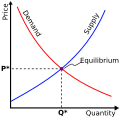| Part of a series on |
| Economics |
|---|
 |
| |

The following outline is provided as an overview of and topical guide to economics. Economics is a branch of science that analyzes the production, distribution, and consumption of goods and services. It aims to explain how economies work and how agents (people) respond to incentives.
Contents
- Branches of economics
- Subdisciplines of economics
- Methodologies or approaches
- Interdisciplinary fields involving economics
- Types of economies
- Economies, by political & social ideological structure
- Economies, by scope
- Economies, by regulation
- Economic elements
- Economic activities
- Economic forces
- Economic measures
- Economic participants
- Economic politics
- Infrastructure
- Markets
- Money
- Resources
- Economic theory
- Economic ideologies
- History of economics
- History of economic thought
- Economic history
- General economic concepts
- Economics organizations
- Economics publications
- Persons influential in the field of economics
- Nobel Memorial Prize–winning economic historians
- See also
- References
- External links
Economics is a behavioral science (a scientific discipline that focuses on the study of human behavior) as well as a social science (a scientific discipline that explores aspects of human society).